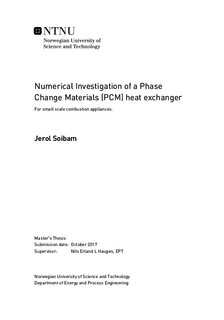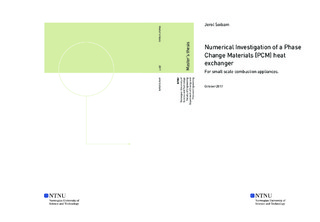| dc.description.abstract | This work mainly focuses on the investigation of heat storage in a PCM, solidification & melting of the PCM and heat release to the surrounding from the storage unit. As the conductivity of PCMs is generally low, fins have been attached to the surface of the pipe to improve the heat transfer in the PCMs. Different lengths, thicknesses, and frequencies of the fins on the pipe are also studied to better understand the behavior of the system. An initial case study is performed considering that a constant temperature is maintained in the inner pipe for the melting and solidification process. To make the problem closer to reality, hot gas was introduced into the inner pipe as a mode of heat generator. The goal of this study is to understand how much heat is stored in the PCM and how much heat it can supply to the surrounding. These numerical simulations are performed using ANSYS FLUENT 17.2.
In the thesis report, the numerical investigation is performed to evaluate the heat transfer rate, melting rate, solidification rate of the PCM (erythritol) and temperature distribution from the PCM in a stovepipe to the surrounding. To enhance the heat, transfer inside the PCM, fins were implemented on the inner pipe wall. Two models were developed for vertical wood stovepipe one with constant wall temperature and another with hot gas flowing in the inner pipe which would serve as the heat generator for the PCM. These models were design and mesh in ANSYS Workbench, and CFD simulation was carried out in ANSYS FLUENT 17.2, and the simulation results were analyzed using Tecplot 360 Ex.
The effects of frequencies of fins in the PCM block was studied, and the computational results showed that having 3 fins for 300 mm pipe was the best solution. The effect of fins lengths cases was also analyzed and compared with no fin case. It showed that having fin lengths of 17.5 mm,35 mm, 52.5 mm and 70 mm fins were 57.8 %, 63.2 %, 68.4 % and 73.6 % faster than without fins for melting 90 % of PCM volume. Further observation was made on heat inputted to the PCM and heat given out of the outer pipe to the surrounding for all the cases, and it showed that 35 mm finned case was the most reliable system for both the models in our case. | |

